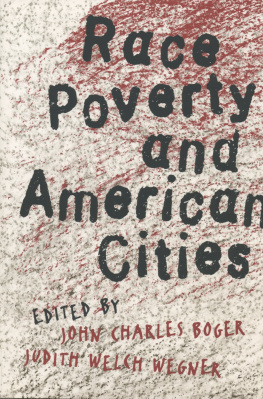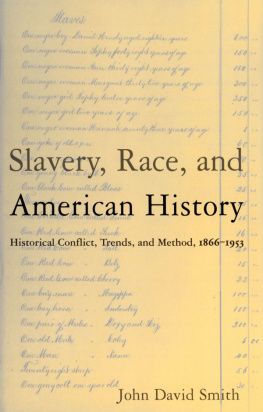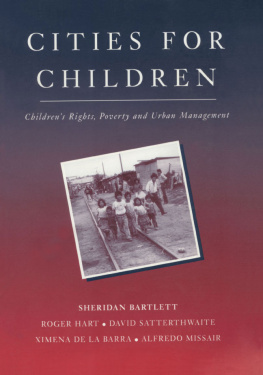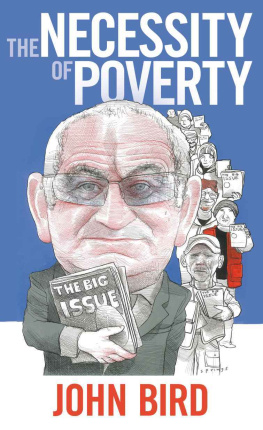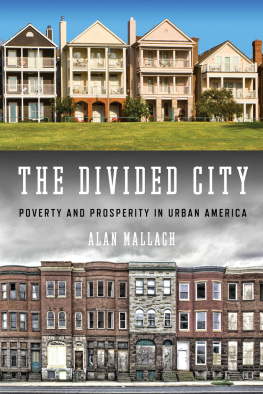Race, Poverty, and American Cities
Race, Poverty, and American Cities
Edited by John Charles Boger and Judith Welch Wegner
The University of
North Carolina Press
Chapel Hill & London
1996 The University of North Carolina Press
All rights reserved
The paper in this book meets the guidelines for permanence and durability of the Committee on Production Guidelines for Book Longevity of the Council on Library Resources.
Library of Congress Cataloging-in-Publication Data
Race, poverty, and American cities \ edited by John Charles Boger and Judith Welch Wegner. p. em. Includes bibliographical references and index.
ISBN 0-8078-2274-4 (cloth: alk. paper)
ISBN 0-8078-4578-7 (pbk.: alk. paper)
1. Cities and townsUnited States. 2. Sociology, Urban-United States. 3. Urban policyUnited States. 4. Urban poorUnited States. 5. United StatesRace relations. I. Boger, John Charles. II. Wegner, Judith Welch.
HT123.R23 1996 95-45056
307.760973dc20 CIP
Publication of this work was aided by a generous grant from the Z. Smith Reynolds Foundation.
Apart from the Afterword, the essays in this volume originally appeared, in somewhat different form, in the North Carolina Law Review 71, no. 5 (June 1993), a special issue entitled SymposiumThe Urban Crisis: The Kerner Commission Report Revisited, 1993 by the North Carolina Law Review Association, Chapel Hill, North Carolina.
00 99 98 97 96 5 4 3 2 1
THIS BOOK WAS DIGITALLY PRINTED.
Dedicated to
Julius LeVonne Chambers
Contents
Preface
Preface
This volume was conceived in the spring of 1992 in sober reflection on the urban crisis plaguing this nation. It came to birth in spring 1995 in the face of growing division between rich and poor, whites and minorities, urban and suburban populations, haves and have-nots.
In April 1992 Americas imagination was gripped by the image of cities burning. A sense of the surreal suffused the nation. White police officers, videotaped in the act of severely beating a black man, Rodney King, were freed by the criminal justice system. Fires leveled South Central Los Angeles, and man-made devastation surpassed that wrought by earthquakes and other natural disasters. Racial tensions flared, sparking both anger and anguish. Political analysts and broadcasters words paled beside the poets:
Things fall apart; the center cannot hold;
Mere anarchy is loosed upon the world,
The blood-dimmed tide is loosed, and everywhere
The ceremony of innocence is drowned;
The best lack all conviction, while the worst
Are full of passionate intensity.1
Los Angelesland of fantasycame to symbolize the grim realities of the new urban crisis, one that drew the nations attention, for a time, until it turned its head.
The South Central riots and their aftermath prompted myriad questions and provided few answers. Will forces such as those at work in Los Angeles in 1992 trigger a growing incidence of urban unrest in the days ahead? Is urban deterioration inevitable? If so, have our great cities outlived their time? Is poverty inextricably linked to race and ethnicity? Are the roots of racism deeper than we can or will acknowledge? Has our system of laws permitted inequity and injustice to persist or simply failed to provide a cure? Have intransigent afflictions such as these defeated our collective imagination or only our will? What lessons might be gleaned from prior incidents of urban strife to shape our policies for the future? No less troubling is the growing recognition that none of these questions can readily be answered in isolation. Instead, meaningful solutions to the problems plaguing Americas cities must be premised on a better understanding of how attitudes about race and poverty, and the fate of evolving urban centers, are inextricably intertwined.
Nearly four years after the South Central riots, the countrys urban crisis and the interrelated issues of race and poverty seem no less pressing and their solutions no more clear. If anything, these issues have grown more compelling and more complex. The economy has become more internationalized, and industrial jobs continue to flee the cities. Health care reform has been attempted with limited success, and center-city hospitals remain overwhelmed with the urban poor. Public concern about violent crime has led to calls for more prisons and longer jail terms. Growing frustration fuels initiatives to curb the rights of illegal immigrants and their children and to revamp the social welfare system. Protesting voices challenge the fairness and wisdom of affirmative action, while racial disparities in employment and educational opportunities continue to grow. The political system has been shaken by shifting partisan coalitions, and proposals to reinvent government have given way to ever simplified solutions and ever more profound distrust.
This volume is based on two fundamental premises. It was conceived in the belief that, when faced with such difficult questions, the nation needs the best answers its scholars can givelest policymakers, in Yeatss words, lack all conviction in facing some of the foremost problems of our time. The essays in this volume bring together the views of those trained in a wide range of disciplineslaw, economics, journalism, geography, business, urban planning, social welfare, and public healthin hopes that their varied insights will shed needed light on complex and intransigent problems facing our cities and their people.
This volume likewise reflects a firm belief that history is a powerful teacher, one whose lessons we dare not ignore. The editors and contributors to this volume have accordingly used as their stepping-off point the Kerner Commission Report,2 commissioned by President Lyndon Johnson in July 1967 and issued in March 1968. The report offers an important context for the present discussion and remarkable measures by which to assess the nations current plight. The Kerner Report provided careful, detailed findings regarding the status of African Americans3 in cities in the late 1960stheir income and employment status, their educational opportunities, their access to health care, their relation to the public welfare system and to the criminal justice system, and their access to political power. This information serves as a useful benchmark for measuring the progress of African Americans and other racial minorities a generation later.
The Kerner Report also contained a series of remarkably clear and explicit policy prescriptions that it promised could revitalize urban America and avoid the development of two nations, one black and one white, separate and unequal. The Kerner Reports strategies for integration and enrichment likewise provided a fruitful framework for discussing the status of African Americans in the late 1960s. That framework continues to provide an important template for assessing changes in the lives of African Americans as is discussed in a number of the essays in this volume. At the same time, that framework has been modified as appropriate in light of significant changes that have occurred as Americas cities have become more multiethnic.
The essays that follow are arranged in six major sections:
(1) Looking Backward and Looking Ahead: Lessons and Questions from the Kerner Commission Report;
(2) An Urban Policy for America: Is Such a Framework Feasible?;
(3) Residential Mobility: Effects on Education, Employment, and Racial Integration;


